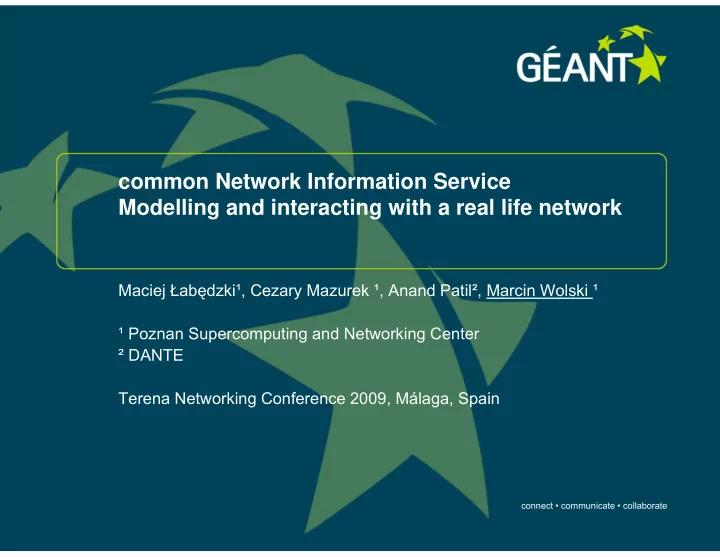

common Network Information Service Modelling and interacting with a real life network Maciej Ł ab ę dzki¹, Cezary Mazurek ¹, Anand Patil², Marcin Wolski ¹ ¹ Poznan Supercomputing and Networking Center ² DANTE Terena Networking Conference 2009, Málaga, Spain connect • communicate • collaborate
From idea into project Virtual network model - a global view of a network’s topology Common Network Information System - unified repository of all relevant network information about a single administrative domain Interacting with real network - efficiently, accurately and automatically collect topology data from the network elements Evaluation – cNIS deployment connect • communicate • collaborate
Motivation Drawbacks • Unified repository of all relevant - Duplication effort - Increased load network information about a single - Data inconsistency AMPS perfSONAR Other - Error prone solutions administrative domain. • Gathering, managing and exposing network topology information Benefits Network Topology Network Topology Network Topology - Single point of storage Database Database Database - Automatic population - Seamless access AMPS perfSONAR Other - Sanity checks cNIS connect • communicate • collaborate
Modeling the network topology Assumptions for cNIS model Generic elements - a view of the network as a set of nodes, ports (interfaces) and links Layered structure - network infrastructure can be divided into several functionally consistent parts which cooperate with each other Inter-layer relations - relations between particular elements of each layer Layer autonomy - due to the layered structure of networks a particular technology can be replaced with another one without influencing the layers above or below Related work DMTF CIM Network Model Network Description Language (NDL) NMWG (Network Measurement Working Group) connect • communicate • collaborate
Additional requirements for network informational model Historical data – support for historical topologies, for example to merge past measurement archives with appropriate topology Future topology – support for future topology, for example to reserve a specific path or to enter and assess changes in a network topology. Audit – to record information who modified the data. Flexibility - no direct or hard-coded relationship between technology specific tables. Tunnelling - relationships between interfaces on the same or different network layers connect • communicate • collaborate
cNIS informational model A joint effort of several NRENs: Common – stores characteristics DANTE, GARR, GRNet, common to all protocols and HEAnet, LRZ, NIIF/USZ, PSNC and network technologies (e.g. Switch ‘description’, ‘unique ID’). IP – the topology of the IP network IP elements SCHEMA Ethernet – the topology of the ETHERNET Ethernet network elements SCHEMA SDH – the topology of the SDH COMMON SDH INTERDOMAIN SCHEMA SCHEMA network elements Fiber – fiber layer FIBER SCHEMA OTH/WDM – optical layer OTH/WDM SCHEMA Interdomain – models virtual cross – domain links. 75 entities in relational schema 91 tables in physical schema connect • communicate • collaborate
Interacting with the network The key to the successful adoption of cNIS is its ability to efficiently, accurately and automatically collect topology SNMP, SSH, data from the network TELNET elements cNIS is meant to manage the infrequently changing part of the network information (static network data) Automatic topology discovery in cNIS is based on a pull method IP network connect • communicate • collaborate
Dataflow in cNIS Geant applications PerfSONAR E2E Monitoring SmokePing Lookup Service AutoBAHN AMPS CNM System Integration with SOAP/NMWG SOAP/NMWG SOAP/XML SOAP/XML PerfSONAR network monitoring infrastructure Users Web browser Management Topology PathFinder AutoBAHN (SOAP/XML) Application Service Service (web application) (SOAP/NMWG) (SOAP/XML) access interfaces With cNDMA framework included Topoloogy data gathered automatically using cNDMA business framework cNIS core logic Network Database data storage connect • communicate • collaborate
cNIS Network Discovery and Management Application (cNDMA) A versatile network discovery engine ready to support any network technology Programming framework for third parties to customize the network discovery platform for a given network plug-ins that create capabilities to extend cNDMA to new vendor/technology specific options drivers – plugin components used to interact with specific network devices. Current set of available plugins IP plugin with two drivers – for Juniper and Cisco routers ( default configuration ) Ethernet plugin SDH plugin connect • communicate • collaborate
cNIS Management Application connect • communicate • collaborate
Deployment GN2 project Pilot deployment on Geant network Test deployment in several NRENs: DFN, FCCN, GARR, HEAnet, Hungarnet and PIONIER GN3 project Moving towards operational deployment in BREN, FCCN, HEAnet, PIONIER and RedIRIS connect • communicate • collaborate
GN3 project GN3 SA2 Task 5: develop and maintain tools that help create domain independent workflows in support of •Multi-domain provisioning of wavelengths. the multi-domain services •Multi-domain provisioning of sub-lambda circuits. •QoS treatment of selected IP traffic flows and aggregates. AMPS, AutoBAHN, cNIS, •Multi-point virtual networks. ISHARe,… •Optical Private Networks Service delivery platform - a platform comprising a set of tools to deliver multi-domain services on top of an existing network infrastructure. GEANT network service delivery platform Participants: BREN, Dante, DFN, GRNET, GARR, MARNET, MREN, NIIF, PSNC (PIONIER), RedIRIS, cNIS AMPS I-SHARe AutoBAHN Switch Common Information Advance Muli- Automated Network Sharing across domain Bandwidth Information Heterogeneous Provisioning Allocation Service Administrative System across Regions Heterogeneous Networks connect • communicate • collaborate
Summary Conclusions Unified model of a computer network for a single administrative domain guarantees reliable operations of networks and services Interacting with a real life network and automatic data gathering is an essential aspect of wide adoption of network repository Future directions Standarization for data exchange model - OGF NML (Network Markup Language), OGF NSI (Network Service Interface), YANG recommendations cNIS framework – network topology discovery, network data model, network information exchange, … connect • communicate • collaborate
More about cNIS Interim GN3 Project Portal, accessible from http://wiki.geant.net/bin/view (available for GN3 participants only) cNIS in PSNC, accessible from http://cnis.psnc.pl/ cNIS development site, accessible from http://stats.geant2.net/cNIS- site/index.html (available for GN3 participants only) GN2-07-045v4 (DS3.13.1): cNIS Database Schema, accessible from http://www.geant2.net/ cNIS demo Wednesday, 14:15 - 15:00 Tuesday, Dante Booth, 11.00 connect • communicate • collaborate
Recommend
More recommend